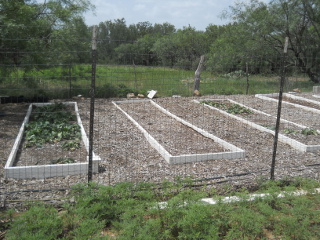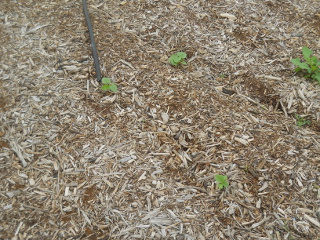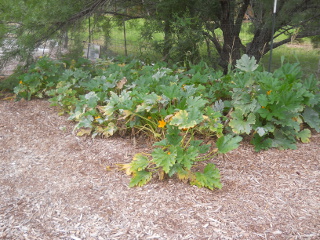It’s been a couple of months since our last garden update, and so we thought we’d show the latest from the garden!
Here is some of the first produce the Lord granted!
And here, we’ll show you around the gardens from early in July. In our 2014 wheat blog post, I mentioned that we had planted turnip seeds back last year, and that nothing had grown. Well, a couple of months ago or more, God granted somewhere around 7 1/2 inches of rain in a few day period; and lo and behold, a bunch of turnips sprouted! Here you can see them (again, early July) in Garden 2, along with the green beans on the right:
And more turnips in the raised beds. The ants started getting to those, so I have since pulled them and fed them to our pig (they were really small):
Again from early July, the zucchini:
The corn:
Tomatoes:
And in the hugelkultur bed:
The following from just yesterday. We’ve been eating the greens from our turnips in salads and sandwiches, and we hope to start to preserve them by lacto-fermentation, which would be our first attempt at that with turnips:
Also, I mentioned in the previous garden blog post that I thought I might try planting okra. I believe I planted them the next day, and none germinated. And so, I tried again, and here are a few that have started!
And here are the tomatoes:
And again, in the hugelkultur bed:
The corn:
And zucchini. We’re getting to the time with them where the inner leaves start to die and any further growth starts occurring farther from the root. We’ve had a lot of flowers, but not a lot of actual fruits, which to me is interesting (apparently other folks here have had some similar issues), but of course, we are thankful for what the Lord has granted:
And here’s another okra:
And here is a lot of the produce being lacto-preserved:
As always, we are so very grateful for the food the Lord is granting us through the gardens; the rains he has brought, with His direct watering, and allowing us to have water stored to water the gardens; and the mulch garden beds, which has allowed for a lot less watering and allowed me to water areas of the gardens without having to monitor the watering minute by minute.
— David
















Thanks, David, for sharing your garden progress with us. Your plants look nice and healthy. I was wondering – does the hugelkultur bed produce better or require less water and nutrients than your other vegetable beds? I am thinking of trying something like it on our small acre, but am not sure if it would be worth it for our hot and rainy climate. Jill
Hi bayougirl,
Well, they way I did the hugelkultur bed, I dug out a pit, put the tree stumps underneath, and covered it all with the mulch. The tomatoes in there have grown some and are making a few fruit, but not much, especially compared to the mulch-bed tomato plants. I hardly water it, mostly because it doesn't seem to make a whole lot of difference, as I have a feeling it's all just falling through into the pit and not really watering what is around the roots of the plants. Still, I don't think moisture is the problem, as most of the plants aren't really dying — I think soil is more of a problem the way I did it. I plan next time, Lord willing, to try to make sure the soil is better prepared.
Now, a normal hugelkultur bed is above ground, with logs and the like, covered with mulch/soil. Maybe that would be a better soil bed. I plan to try at some point to build one of those next to the current bed.
I think the moisture part will work well eventually, but, in my opinion, nutrients one still has to tend too, regardless of how the soil is put together.
Hope it works out well for you if you try it!
— David
What type of wood was used? A lot of trees have acids that kill other plants or at least inhibit growth. Oak walnut buckeyes, just to name a few. If their wood is in your mulch or beds, it would be totally counterproductive
Hi adele,
Here's some info regarding that, from:
http://www.finegardening.com/mulch-healthy-garden
"As mulch decomposes, it releases either acidic or alkaline substances into the soil, depending on the mulch. This only matters if you’re trying to grow acid-loving plants like azaleas and rhododendrons. For these plants, use a mulch that releases acid, such as pine straw, pine bark (which is also high in aluminum), true cypress, and some species of eucalyptus. In contrast, hardwood mulches tend to become alkaline and are good for almost any plant that doesn’t require an acidic environment."
Most of ours is probably mesquite (a hardwood) and juniper, maybe a little oak.
Thanks for your concern!
— David